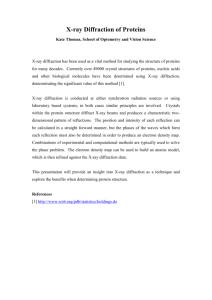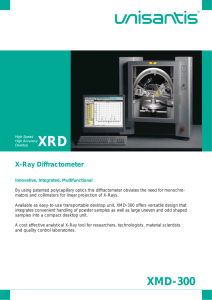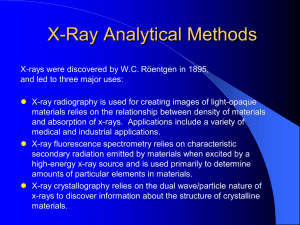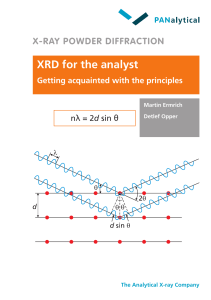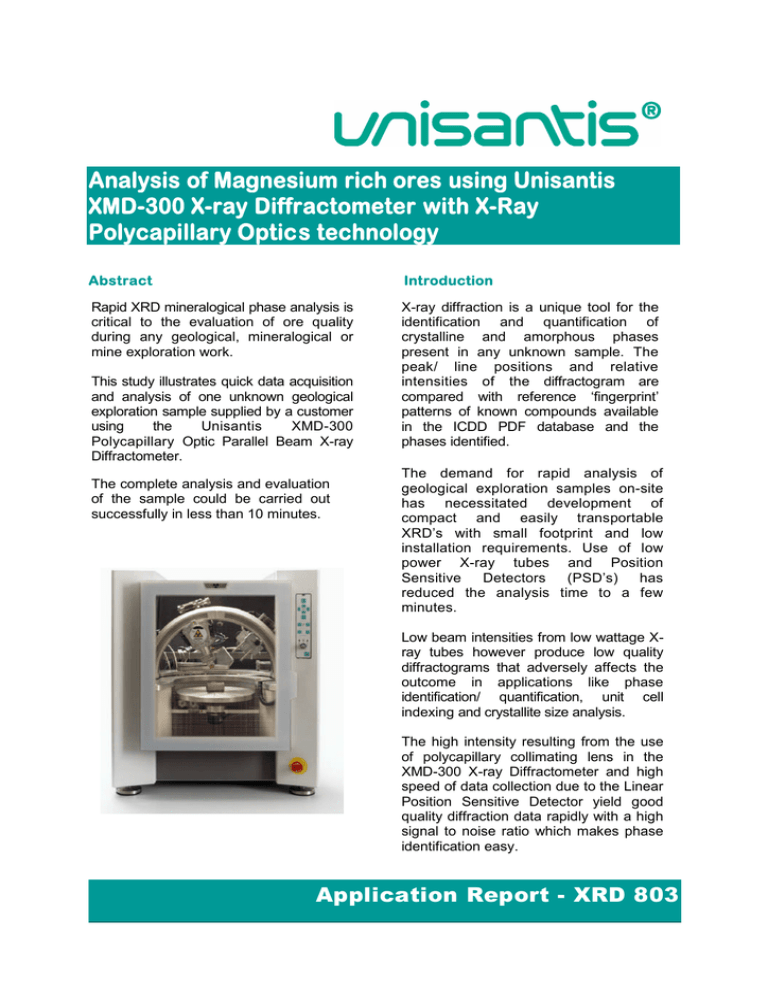
Analysis of Magnesium rich ores using Unisantis
XMD-300 X-ray Diffractometer with X-Ray
Polycapillary Optics technology
Abstract
Introduction
Rapid XRD mineralogical phase analysis is
critical to the evaluation of ore quality
during any geological, mineralogical or
mine exploration work.
X-ray diffraction is a unique tool for the
identification and quantification of
crystalline and amorphous phases
present in any unknown sample. The
peak/ line positions and relative
intensities of the diffractogram are
compared with reference ‘fingerprint’
patterns of known compounds available
in the ICDD PDF database and the
phases identified.
This study illustrates quick data acquisition
and analysis of one unknown geological
exploration sample supplied by a customer
using
the
Unisantis
XMD-300
Polycapillary Optic Parallel Beam X-ray
Diffractometer.
The complete analysis and evaluation
of the sample could be carried out
successfully in less than 10 minutes.
The demand for rapid analysis of
geological exploration samples on-site
has necessitated development of
compact and easily transportable
XRD’s with small footprint and low
installation requirements. Use of low
power X-ray tubes and Position
Sensitive
Detectors
(PSD’s)
has
reduced the analysis time to a few
minutes.
Low beam intensities from low wattage Xray tubes however produce low quality
diffractograms that adversely affects the
outcome in applications like phase
identification/ quantification, unit cell
indexing and crystallite size analysis.
The high intensity resulting from the use
of polycapillary collimating lens in the
XMD-300 X-ray Diffractometer and high
speed of data collection due to the Linear
Position Sensitive Detector yield good
quality diffraction data rapidly with a high
signal to noise ratio which makes phase
identification easy.
Application Report - XRD 803
Table 1. System Configuration
Unisantis XMD-300 Diffractometer
X-Ray Tube
50 W; Air cooled; Cu anode
Incident Beam Optics
Polycapillary collimating lens
Tube Voltage
45 kV
Tube Current
0.8 mA
Detector
Position Sensitive Detector
Sample Stage
Standard sample stage with laser alignment
The complete scan was recorded by measuring 8 times a 10° interval during
60 seconds, which corresponds to the active length of the PSD. These
measurements were subsequently concatenated.
The diffractogram for this sample was obtained using the above instrumental
configuration and is shown in Fig.1.
Fig.1. X-ray diffraction pattern for the sample obtained from Unisantis XMD-300
Search-match was conducted on the diffractogram obtained for this sample
followed by quantitative phase analysis using the RIR (Reference Intensity
Ratio) method. The result is given in Fig.2.
Fig.2. Mineral phases identified in the sample and Quantitative analysis results
Results
Analysis was carried out on the raw
diffraction pattern obtained for this
sample.
The best search-match hit was found to
be Periclase. Two other phases were
also present in substantial quantity and
identified as Forsterite and Olivine. The
ICDD PDF stick patterns for the best
search-match results are shown
alongwith the quantitative analysis
results.
The analytical results and all graphics
can be integrated into WINDOWSTM
and MSOFFICE based packages for
reporting and documentation.
It may be noted that the XRD data for
each sample, covering the entire 2Theta
range, was collected in only 8 minutes
with high intensity and excellent signal
to noise ratio.
Conclusions
The present study demonstrates that
Unisantis XMD 300 Polycapillary Optic
X-ray Diffractometer provides rapid and
reliable data that is highly suitable for
all X-ray diffraction studies such as
phase
identification,
phase
quantification,
crystallite
size
measurement and unit cell indexing.
It may be noted that due to its parallel
beam geometry the data provided by
XMD is without any instrumental errors
known to be associated with
conventional powder diffractometers
such as sample displacement error,
sample transparency errors, etc.
The quality of diffraction data obtained
using a low power tube is exceptionally
good considering the fact that the
data has not been corrected for any of
the errors known to be generally
associated with powder diffraction
experiments
Company profile
Unisantis Europe GmbH is a global leader in development and manufacturing of innovative
X-Ray analytical instrumentation, complete solutions and software for structure and
elemental analysis using proprietary Polycapillary optics known for best beam
collimation. Success in research has enabled Unisantis Europe GmbH to develop new
cutting-edge X-ray technology, applications and products for the market. Our products
have particular applications in material characterization, life science and industrial
analysis.
Unisantis instruments incorporate a new range of user benefits, including
transportability and multi-functionality all comprised in compact, bench top, user friendly,
environmentally safe and low energy consumption equipment.
Unisantis
Headquarter
Unisantis Europe GmbH
Werner-von-Siemens-Strasse 31
49124 Georgsmarienhütte
Germany
Tel: + 49 5401 3681 40
Fax: + 49 5401 3681 50
E: sales@unisantis.com
Unisantis FZE
P.O Box: 17667
Dubai, United Arab Emirates
Tel: + 971 4 808 44 44
Fax: + 971 4 881 98 98
E: info-me@unisantis.com
© 2008 Unisantis Europe GmbH. All rights
reserved.
All configurations and specifications are subject to
change without prior notice
sales@unisantis.com
www.unisantis.com



